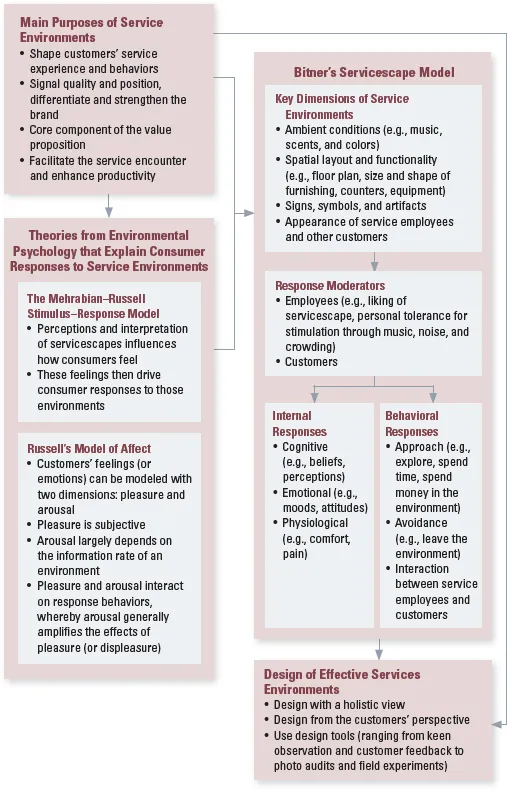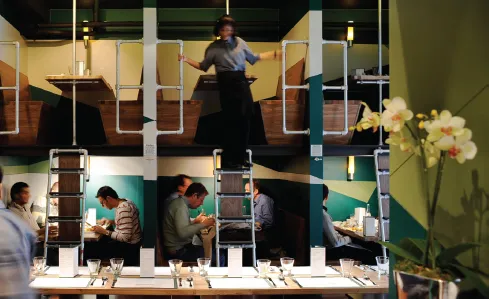![]()
VOLUME 8
Crafting The Service Environment
Managers…need to develop a better understanding of the interface between the resources they manipulate in atmospherics and the experience they want to create for the customer.
Jean-Charles Chebat and Laurette Dubé
Professors of Marketing at HEC Montréal Business School and McGill University, Montréal respectively
Restaurant design has become as compelling an element as menu, food and wine…in determining a restaurant’s success.
Danny Meyer
New York City restaurateur and CEO of Union Square Hospitality Group
SERVICE ENVIRONMENTS — AN IMPORTANT ELEMENT OF THE SERVICE MARKETING MIX
The physical service environment customers experience plays a key role in shaping the service experience and enhancing (or undermining) customer satisfaction, especially in high-contact, people-processing services.1 Disney theme parks are often cited as vivid examples of service environments that make customers feel comfortable and highly satisfied, and leave a long-lasting impression. In fact, organizations such as hospitals, hotels, restaurants, and offices of professional service firms have come to recognize that the service environment is an important element of their services marketing mix and overall value proposition.
Designing the service environment is an art that involves a lot of time and effort, and can be expensive to implement. Service environments, also called servicescapes, relate to the style and appearance of the physical surroundings and other experiential elements encountered by customers at service delivery sites.2 Once designed and built, service environments are not easy to change. The focus of this volume is on the key dimensions of service environments in the servicescape model and not much on its other aspects (Figure 1).
WHAT IS THE PURPOSE OF SERVICE ENVIRONMENTS?
The reason why many service firms take so much trouble to shape the environment in which their customers and service personnel will interact will need to be examined. For many service firms, there are four main purposes of servicescapes: (1) shape customers’ experiences and behaviors; (2) signal quality and position, differentiate and strengthen the brand; (3) be a core component of the value proposition; and (4) facilitate the service encounter and enhance both service quality and productivity. Each of these four purposes are discussed in the following sections.
Shape Customers’ Service Experiences and Behaviors
For organizations that deliver high-contact services, the design of the physical environment and the way in which tasks are performed by customer–contact personnel play a vital role in shaping the nature of customers’ experiences. Physical surroundings help to “engineer” appropriate feelings and reactions in customers and employees, which in turn can help to build loyalty to the firm.3 The environment and its accompanying atmosphere can affect buyer behavior in important ways, and this volume describes how the design elements of the service environment can make customers feel excited or relaxed, help them find their way in complex servicescapes such as hospitals or airports, and shape their quality perceptions and important outcomes such as buying behavior, satisfaction and repeat purchase.
Figure 1: Organizational framework
Signal Quality, and Position, Differentiate and Strengthen the Brand
Services are often intangible and customers cannot assess their quality well, so customers use the service environment as an important quality proxy, and firms go to great lengths to signal quality and portray the desired image.4 For example, the reception area of successful professional service firms such as investment banks or management consulting firms, where the decor and furnishings tend to be elegant and are designed to impress.
Most people infer higher merchandise quality if the goods are displayed in an environment with a prestigious image rather than in one that feels cheap.5 Consider Figure 2, which shows the lobbies of two hotels. These are two different types of hotels catering to two very different target segments. One caters to younger guests who love fun and have low budgets, and the other caters to a more mature, affluent and prestigious clientele including business travelers. Each of these two servicescapes clearly communicates and reinforces each hotel’s respective positioning and sets service expectations as guests arrive.
Figure 2: Compare the two hotel lobbies; different types of hotels have very different target segments.
Servicescapes often play an important part in building a service firm’s brand, such as the role outlet design played in building Starbucks’ brand! Likewise, Apple is famous for its sleek design, and their shops are no exception. With their airy and minimalist interiors, white lighting, silver steel, and beige timber, Apple Stores create a bright, open and futuristic servicescape that provides a carefree and casual atmosphere. Apple’s flagship stores feature dramatic locations such as inside the Louvre in Paris, or a 40-foot-high glass cylinder in Shanghai. Apple’s retail operations are an important part of its business — it has 453 retail stores in 16 countries; of its 43,000 employees in the US, 30,000 work at Apple Stores, and its sales per square foot of $4,551 per annum in 2014 were the highest of any retailer in the US!6 The Apple Stores’ ability to deliver a consistent, differentiated, and high quality service experience reinforces Apple’s brand image, and is consistent with the upmarket and high quality positioning of its products.
Core Component of the Value Proposition
The servicescape can even be a core component of a firm’s value proposition. Consider how effectively many amusement parks use the servicescape concept to engineer their visitors’ service experiences as they come to these parks to enjoy the environment and rides. The clean environment of Disneyland or Denmark’s LEGOLAND® (Figure 3), in addition to employees in colorful costumes all contribute to the sense of fun and excitement that visitors encounter upon arrival and throughout their visit.
Figure 3: In LEGOLAND®, the servicescape is part of the value proposition.
Figure 4: At the Mirage Hotel and Casino in Las Vegas, an erupting volcano is part of the servicescape.
Resort hotels illustrate how servicescapes can become a core part of the value proposition. Club Med’s villages, designed to create a totally carefree atmosphere, may have provided the original inspiration for “getaway” holiday environments. However, new destination resorts are not only far more luxurious than Club Med, but also draw inspiration from theme parks to create fantasy environments both indoors and outdoors. Perhaps the most extreme examples can be found in Las Vegas. Facing competition from numerous casinos in other locations, Las Vegas has repositioned itself away from being a purely adult destination, to a somewhat more wholesome entertainment destination where families too can have fun. The gambling is still there, but many of the large, recently built hotels (or rebuilt) have been transformed by adding visually attractive features, e.g., erupting “volcanoes”, (Figure 4) mock sea battles, striking reproductions of Paris, pyramids of Egypt, and Venice and its canals.
Figure 5: Bangalore Express City, a restaurant in the city of London, is designed to optimize expensive rental space.
Facilitate the Service Encounter and Enhance Productivity
Service environments are often designed to facilitate the service encounter and increase productivity. For example, childcare centers use toy outlines on walls and floors to show where toys should be returned after use. In fast food restaurants and school cafeterias, strategically located tray-return stands and notices on walls remind customers to return their trays. As shown in the Bangalore Express Restaurant (Figure 5), environments can be designed to optimize the use of expensive rental space. Finally, Service Insights 1 shows how the design of hospitals helps patients recover and employees perform better.
SERVICE INSIGHTS 1
The Hospital Servicescape and Its Effects on Patients and Employees7
Thankfully, most of us do not have to stay in hospitals. If it should happen, we hope our stay will allow us to recover in a suitable environment. However, what is considered suitable in a hospital?
Patients may contract infections while in hospital, feel stressed due to the contact with many strangers, and yet become bored without much to do, dislike the food, or are unable to rest well. All these factors may delay a patient’s recovery. Medical workers usually work under demanding conditions and may contract infectious diseases, be stressed by the emotional labor of dealing with difficult patients, or be at risk of injury when exposed to various types of medical equipment. Research has shown that greater care in designing the hospital servicescape reduces these risks and contributes to patient well-being and recovery, as well as staff welfare and productivity.
The recommendations include:
•Provide single-bed rooms. These can lower the number of infections caught in the hospital, improve rest and sleep quality by lessening disturbance caused by other patients sharing the room, increase patient privacy, facilitate social support by families, and even improve communication between staff and patients.
•Reduce noise levels. This leads to decreased stress levels for staff, and improved sleep for patients.
•Provide distractions for patients, including areas of greenery and nature for them to visit or see from their beds, personalized televisions with headphones to avoid disturbing others, internet access...





